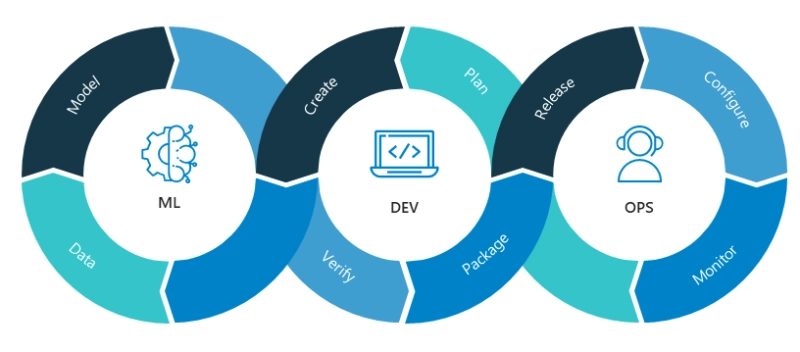
In today’s rapidly evolving digital landscape, organizations across industries embrace cloud computing as a catalyst for innovation and growth. Cloud technologies offer unparalleled scalability, flexibility, and cost-efficiency, empowering businesses to embark on transformative digitalization journeys. This comprehensive article explores how cloud computing fuels digital transformation, enabling organizations to adapt to changing market dynamics, enhance operational efficiency, and drive sustainable business success.
The Foundations of Digital Transformation
Digital transformation is a strategic imperative for organizations seeking to thrive in the digital age. At its core, digital transformation entails leveraging digital technologies to reimagine business processes, enhance customer experiences, and create new value propositions. Cloud computing is the foundation upon which digital transformation initiatives are built, providing the infrastructure, platforms, and services needed to accelerate innovation and drive business outcomes.
- Scalability and Elasticity
Cloud computing offers unparalleled scalability and elasticity, allowing organizations to scale resources up or down based on fluctuating demand. Whether provisioning additional computing power to accommodate peak workloads or scaling back resources during periods of low activity, the cloud provides the agility and flexibility needed to adapt to changing business requirements. This scalability enables organizations to innovate rapidly, experiment with new ideas, and swiftly respond to market opportunities.
- Accessibility and Ubiquity
The cloud democratizes access to advanced technologies and computing resources, levelling the playing field for businesses of all sizes. With cloud services accessible via the internet from anywhere in the world, organizations can harness the power of cutting-edge technologies without the need for significant upfront investments in hardware or infrastructure. This accessibility fosters collaboration, innovation, and knowledge sharing, driving collective progress and accelerating digital transformation efforts across industries.
- Cost-Efficiency and Resource Optimization
Traditional on-premises IT infrastructure often entails significant upfront capital expenditures and ongoing maintenance costs. In contrast, cloud computing operates on a pay-as-you-go pricing model, enabling organizations to pay only for the resources they consume. This cost-efficient pricing structure eliminates the need for large upfront investments, while the ability to dynamically provision resources based on demand ensures optimal resource utilization and cost optimization. Organizations can redirect financial resources towards strategic initiatives that drive growth and innovation by leveraging cloud services.
Enabling Innovation and Agility
At the heart of digital transformation lies innovation and agility as organizations seek to differentiate themselves in an increasingly competitive marketplace. Cloud computing catalyzes innovation, providing the tools, platforms, and capabilities needed to fuel creativity and drive product development, customer engagement, and operational excellence breakthroughs.
- Accelerated Development Cycles
Cloud computing enables organizations to accelerate software development cycles and bring new products and services to market faster. With cloud-based development platforms and tools, teams can collaborate in real time, streamline workflows, and iterate on solutions rapidly. The cloud also provides access to a rich ecosystem of pre-built services and APIs, allowing developers to leverage advanced capabilities such as artificial intelligence, machine learning, and data analytics without requiring extensive coding or infrastructure setup.
- Experimentation and Iteration
Digital transformation is inherently iterative, requiring organizations to experiment, learn, and adapt in response to changing market dynamics and customer feedback. Cloud computing provides a sandbox environment for experimentation, enabling organizations to test new ideas, prototypes, and business models with minimal risk. By leveraging cloud-based infrastructure and services, organizations can iterate on solutions quickly, gather real-time feedback, and refine their strategies based on empirical data and insights.
- Agile Business Operations
In today’s fast-paced business environment, agility is a critical differentiator for organizations seeking to stay ahead of the curve. Cloud computing enables agile business operations by providing the infrastructure and tools to streamline workflows, automate processes, and respond rapidly to market changes. From supply chain optimization and customer relationship management to financial planning and human resource management, the cloud empowers organizations to adapt to evolving requirements and seize opportunities quickly and precisely.
Enhancing Customer Experiences
Central to digital transformation is the imperative to deliver exceptional customer experiences that drive loyalty, satisfaction, and advocacy. Cloud computing enhances customer experiences by providing the scalability, flexibility, and insights needed to deliver personalized, seamless, and engaging interactions across all touchpoints.
· Personalization and Customization
The cloud enables organizations to leverage data-driven insights to personalize individual customer products, services, and experiences. Organizations can comprehensively understand customer preferences, behaviours, and pain points by aggregating and analyzing data from disparate sources. Cloud-based analytics platforms and machine learning algorithms empower organizations to segment their customer base, identify trends and patterns, and deliver targeted offerings that resonate with specific audience segments.
· Omnichannel Engagement
Customers expect seamless and consistent experiences across all channels and devices in an increasingly connected world. Cloud computing facilitates omnichannel engagement by providing a unified platform for managing customer interactions and touchpoints. Whether through websites, mobile apps, social media, or physical storefronts, organizations can leverage cloud-based CRM systems and marketing automation tools to orchestrate personalized, omnichannel experiences that drive engagement and loyalty.
· Real-Time Responsiveness
The cloud enables organizations to respond to real-time customer inquiries, feedback, and requests, ensuring timely and personalized interactions at every customer journey stage. Cloud-based customer service platforms and chatbots leverage natural language processing and machine learning to automate routine tasks, resolve common issues, and provide 24/7 support across multiple channels. Organizations can foster trust, loyalty, and long-term customer relationships by delivering responsive and empathetic customer service.
Empowering Data-Driven Decision-Making
Data is the lifeblood of digital transformation, providing organizations with valuable insights and intelligence to inform strategic decisions, optimize operations, and drive innovation. Cloud computing catalyzes data-driven decision-making, providing the infrastructure, tools, and capabilities needed to harness the power of data and derive actionable insights at scale.
· Scalable Data Storage and Processing
The volume, variety, and velocity of data generated by modern businesses present opportunities and challenges for organizations seeking to extract value from their data assets. Cloud computing provides scalable and cost-effective solutions for storing, processing, and analyzing large volumes of data in real time. Cloud-based data lakes and warehouses enable organizations to consolidate data from disparate sources, perform complex analytics, and derive meaningful insights to drive business outcomes.
· Advanced Analytics and Machine Learning
Cloud computing democratizes access to advanced analytics and machine learning capabilities, enabling organizations to uncover hidden patterns, trends, and correlations within their data. Cloud-based analytics platforms and machine learning services provide pre-built models and algorithms that empower organizations to easily perform predictive analytics, anomaly detection, and sentiment analysis. By harnessing the power of AI and machine learning, organizations can optimize processes, automate decision-making, and unlock new opportunities for innovation and growth.
· Real-Time Business Intelligence
In today’s fast-paced business environment, the ability to access real-time insights is critical for making informed decisions and staying ahead of the competition. Cloud computing enables real-time business intelligence by providing organizations with access to dashboards, reports, and visualizations that deliver actionable insights at the speed of business. Cloud-based BI tools and analytics platforms empower users to monitor key performance indicators, track business metrics, and uncover opportunities for optimization in real time, enabling agile decision-making and continuous improvement.
Driving Operational Efficiency and Agility
Digital transformation is not just about improving customer experiences; it’s also about optimizing internal processes, enhancing collaboration, and driving operational efficiency. Cloud computing catalyzes operational excellence, providing organizations with the tools and technologies needed to streamline workflows, automate routine tasks, and empower employees to work smarter, not harder.
· Streamlined Workflows and Collaboration
The cloud enables organizations to streamline workflows and facilitate collaboration among employees, partners, and stakeholders across geographies and time zones. Cloud-based productivity suites and collaboration tools provide a centralized platform for sharing documents, scheduling meetings, and collaborating on real-time projects. From document editing and version control to video conferencing and instant messaging, the cloud empowers teams to work together more effectively, regardless of their physical location or device.
· Process Automation and Optimization
Automation is key to operational efficiency and reducing manual overhead in today’s digital-first world. Cloud computing enables organizations to automate routine tasks, workflows, and business processes using robotic process automation (RPA) and workflow orchestration tools. By automating repetitive tasks such as data entry, invoice processing, and inventory management, organizations can free up valuable time and resources, minimize errors, and focus on high-value activities that drive business outcomes.
· Agile Infrastructure and DevOps Practices
Cloud computing enables organizations to adopt agile infrastructure and DevOps practices that accelerate software delivery and improve collaboration between development and operations teams. Infrastructure-as-code (IaC) tools and cloud-native services enable organizations to provision, configure, and manage infrastructure resources programmatically, reducing manual overhead and ensuring consistency across environments. Continuous integration and continuous deployment (CI/CD) pipelines enable developers to deliver new features and updates to production quickly and reliably, fostering a culture of experimentation, innovation, and continuous improvement.
Enhancing Business Resilience and Continuity
Resilience and continuity are critical for business survival in an increasingly interconnected and unpredictable world. Cloud computing is pivotal in enhancing business resilience and continuity by providing organizations with the tools and technologies needed to mitigate risks, respond to disruptions, and ensure uninterrupted operations in the face of unforeseen challenges.
· Disaster Recovery and Business Continuity
Cloud computing offers cost-effective disaster recovery and business continuity solutions, leveraging geographically dispersed data centres and resilient architecture to ensure high availability and data durability. Cloud-based disaster recovery services enable organizations to replicate data and applications to the cloud, providing rapid failover and recovery capabilities during a disaster or outage. Organizations can minimize downtime, mitigate risks, and safeguard business operations against disruptions by decoupling infrastructure from physical locations and adopting multi-cloud or hybrid cloud strategies.
· Scalable and Resilient Architecture
The cloud provides organizations with the scalability and resilience to handle unpredictable demand and withstand unexpected events. Cloud-native architectures such as microservices and serverless computing enable organizations to build scalable, fault-tolerant applications that can handle spikes in traffic and gracefully degrade during failures. Auto-scaling and load-balancing mechanisms ensure that resources are provisioned dynamically based on demand, optimizing performance and minimizing costs while maintaining high availability.
· Security and Compliance
Security is a top priority for organizations migrating to the cloud, and cloud computing providers offer a wide range of security features and controls to protect sensitive data and workloads. From identity and access management (IAM) and encryption to network security and threat detection, cloud providers implement industry-leading security practices to safeguard customer data and infrastructure. Additionally, cloud compliance certifications and regulatory frameworks ensure that organizations remain compliant with industry-specific regulations and standards, mitigating risks and maintaining trust with customers and stakeholders.
Enabling Industry-Specific Transformation
Digital transformation is not a one-size-fits-all endeavour; it’s a journey that varies depending on industry dynamics, market trends, and organizational goals. Cloud computing enables industry-specific transformation by providing tailored solutions and specialized services that address different sectors’ unique challenges and opportunities.
· Healthcare: Improving Patient Outcomes
In the healthcare industry, cloud computing drives innovation. It improves patient outcomes by facilitating the exchange of electronic health records (EHRs), enabling telemedicine services, and supporting advanced analytics for personalized medicine. Cloud-based healthcare platforms and medical imaging solutions empower providers to deliver more efficient, accessible, and personalized patient care while ensuring compliance with regulatory requirements such as HIPAA.
· Financial Services: Enhancing Security and Compliance
In financial services, cloud computing revolutionizes operations, enhances security, and enables agile innovation. Cloud-based banking platforms and fintech solutions provide banks and financial institutions the agility and flexibility needed to adapt to changing market conditions, launch new products and services, and deliver seamless omnichannel experiences to customers. Cloud providers offer specialized services for financial services organizations, such as secure data storage, fraud detection, and compliance monitoring, enabling organizations to mitigate risks and comply with regulatory requirements while driving growth and innovation.
· Retail: Transforming the Customer Experience
In the retail industry, cloud computing transforms the customer experience, enabling retailers to deliver personalized, seamless, and omnichannel shopping experiences to consumers. Cloud-based e-commerce platforms and retail analytics solutions provide retailers with real-time insights into customer preferences, behaviours, and trends, enabling them to optimize product assortments, pricing strategies, and marketing campaigns to drive sales and loyalty. Additionally, cloud-based inventory management and supply chain solutions enable retailers to streamline operations, reduce costs, and improve efficiency across the value chain.
Overcoming Challenges and Barriers
While cloud computing offers numerous benefits for organizations embarking on digital transformation journeys, it also presents challenges and barriers that must be addressed to maximize success and ensure sustainable outcomes.
· Data Privacy and Security Concerns
Data privacy and security concerns are at the top of organizations’ minds when considering cloud adoption, particularly in regulated industries or regions with stringent compliance requirements. Organizations must assess cloud providers’ security capabilities and compliance certifications, implement robust security controls and encryption mechanisms, and establish clear policies and procedures for data protection and access management. Additionally, organizations should conduct regular security audits and risk assessments to proactively identify vulnerabilities and mitigate risks.
· Legacy System Integration and Migration
Legacy systems and infrastructure pose challenges for organizations seeking to migrate to the cloud, as they may need more compatibility with modern cloud environments or require significant reengineering efforts. Organizations must develop a comprehensive migration strategy that addresses the complexities of legacy system integration, data migration, and application modernization. Cloud migration tools and services can help automate and minimize disruption. In contrast, hybrid cloud and multi-cloud architectures enable organizations to adopt a phased approach to cloud adoption, preserving investments in existing infrastructure while gradually transitioning to the cloud.
· Skills Gap and Talent Shortages
The rapid pace of technological change and the evolving nature of cloud computing present challenges for organizations seeking to build and retain a skilled workforce. Organizations must invest in employee training and development programs to equip staff with the knowledge and skills to effectively leverage cloud technologies. Additionally, organizations can leverage managed services and cloud consulting partners to augment internal capabilities and accelerate cloud adoption initiatives, leveraging the expertise of experienced professionals to navigate complex challenges and achieve desired outcomes.
Embracing the Cloud-Centric Future
Cloud computing has emerged as a driving force behind digital transformation, empowering organizations to innovate, adapt, and thrive in an increasingly competitive and interconnected world. By harnessing the power of the cloud, organizations can accelerate innovation, enhance agility, and drive sustainable growth while overcoming challenges and barriers. As organizations continue to embrace the cloud-centric future, they will unlock new opportunities for innovation, differentiation, and value creation, shaping the future of business and society in the digital age.




